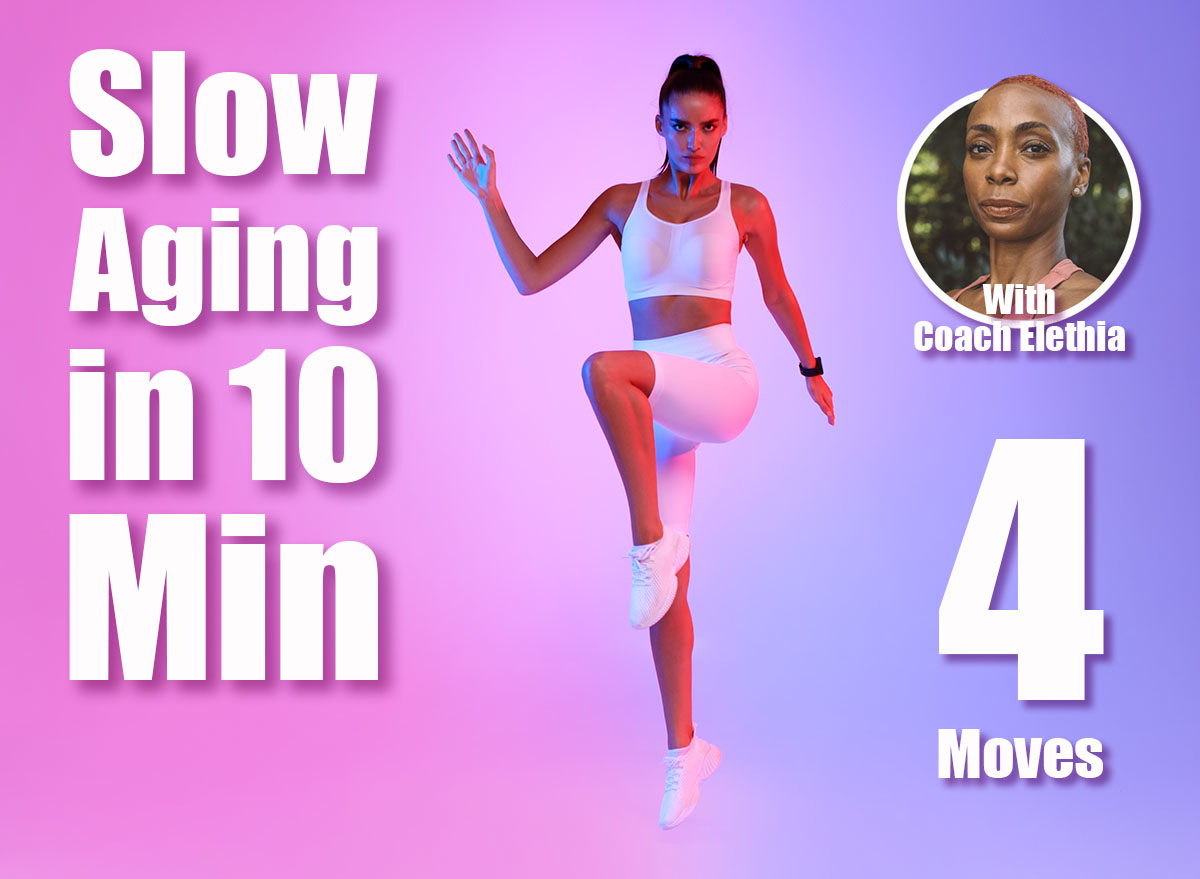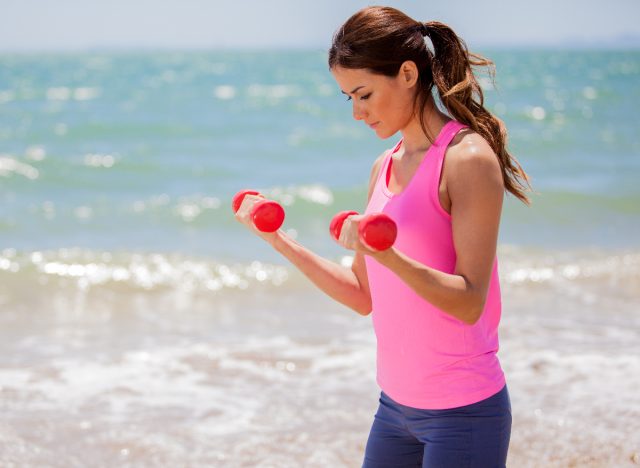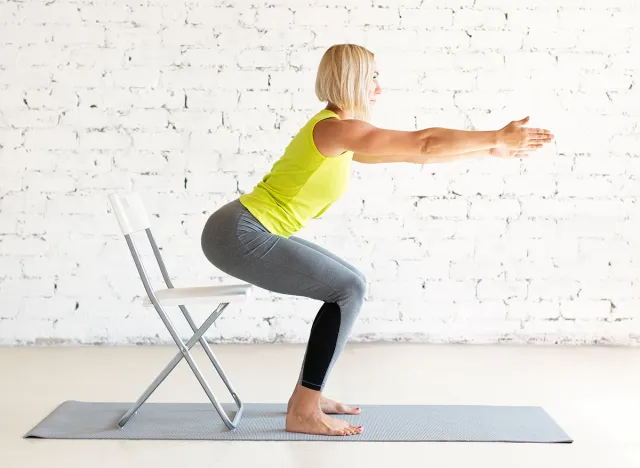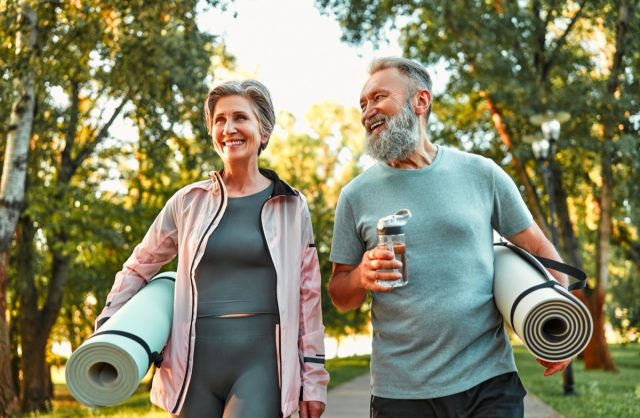4 Quick Standing Exercises That Slow Aging Faster Than Gym After 40

Hitting your 40s brings changes you can’t ignore—from struggling to get out of chairs that never used to be a problem to noticing your metabolism isn’t what it once was. The good news is that you don’t need expensive gym memberships or complicated machines to fight back against these age-related changes. These four simple standing exercises can be more effective than traditional gym workouts at keeping you strong, energized, and independent as you age.
Why You’re Noticing These Changes After 40

As I entered my 40s, I began noticing familiar age-related changes. One major sign was full-blown menopause following a partial hysterectomy. Let the hot flashes begin!
Other signs can include:
Sarcopenia – the loss of muscle mass. Have you or someone else experienced a greater challenge getting out of a chair you used to sit in? Research shows it often starts as early as our mid-30s. If you don’t counteract it with strength work, adults typically lose about 4–6 pounds of muscle per decade.
Metabolism slows – Remember how easy it was to burn off that birthday cake or can of beer? Even if the scale stays the same, without consistent work, body fat can creep up.
Hormonal changes like perimenopause affect many women over 40, causing hot flashes, night sweats, and mood swings. Meanwhile, men experience gradual testosterone declines, leading to fatigue and weight gain.
For those 40+, have you noticed feeling a bit more tired doing those everyday chores? It’s totally normal if your core isn’t as strong as it once was. Things like climbing stairs or carrying groceries might feel just a tad more challenging.
Why Standing Beats Gym Machines For Slowing Aging

Standing exercises are more effective than traditional gym machine workouts because standing workouts help maintain functional fitness (an exercise style that mimics and supports the movements of daily life) and postural alignment, which are key for staying active and maintaining independence as we age. Something many of us value.
Standing functional exercises, compared to isolated machine workouts, contribute to slowing the effects of aging due to the following:
- Seated gym machines may isolate one muscle. Often times we sit on that machine and conform to the machine. Standing moves force your entire body to stabilize and balance through the kinetic chain. For example, during a free-standing biceps curl, your abs and back must engage to keep you upright. These are areas a machine would otherwise support.
- Standing exercises mimic real-life movements. For instance, a standing bicep curl is similar to lifting grocery bags from a cart. Both challenge your balance and coordination while building strength throughout the body; facilitating postural alignment.
Your 4 Anti-Aging Standing Exercises
In my workout routine, I focus on compound standing moves that hit multiple muscle groups. Here are four of my top standing exercises that combat specific aging signs (muscle loss, poor balance, weak core), plus how to do them right. You can use your body weight for each move or add light dumbbells and resistance bands for more resistance.
Squats
Squats are a cornerstone exercise for leg and hip strength. They target the quads, glutes, hamstrings and core, so they fight sarcopenia and bone loss in the lower body. Stronger legs make everyday activities (standing up, climbing stairs) easier and help preserve bone density.
How to do it:
- Stand with feet shoulder-width apart
- Keep your chest up and core braced
- Push your hips back and bend your knees (as if sitting into a chair)
- Lower until your thighs are about parallel to the floor (or as low as comfortable)
- Press back through your heels to stand up
- Aim for 2–3 sets of 10–15 reps
Common mistakes: Avoid letting your knees collapse inward or shoot too far forward; keep them aligned over your toes. Don’t round your back – maintain a neutral spine by bracing your core. Also, don’t rise onto your toes; keep the weight through your heels to protect your knees.
Overhead Shoulder Press
This standing press strengthens shoulders, triceps, and upper back, helping counteract the forward-rolled shoulders that can come from office work and aging. By pressing weight overhead from a standing position, you engage not only the deltoids and triceps but also the core and upper-back stabilizers.
How to do it:
- Hold a dumbbell (or soup can) in each hand at shoulder height (elbows bent)
- Keep feet hip-width apart and brace your core
- Press both weights straight overhead until your arms are fully extended (but avoid locking elbows hard) • Lower slowly back to shoulder height
- Perform 8–12 reps for 2–3 sets
Common mistakes: Don’t arch your lower back – press your ribcage down and core in to keep your spine neutral. Avoid shrugging your shoulders; keep them down and relaxed as you press up. Also, don’t flare your ribs or lean forward as the weights go up. If you feel shoulder pain, use a lighter weight.
Standing Rows (Resistance Band or Dumbbell)
Pulling exercises strengthen the upper back and rear shoulders. This exercise pulls your shoulders back and trains the muscles that prevent the back from rounding – avoiding the hunched look of aging. A standing row (with a resistance band or bent-over row with dumbbells) hits the lats, rhomboids, and biceps while telling the core, Get to work!
How to do it:
- While standing, hold a resistance band at chest height (or hold a pair of dumbbells) • Hold arms shoulder-width apart, making sure there’s tension in the band
- Brace your abs and stand upright
- Pull your hands toward your ribcage, bending elbows and squeezing shoulder blades together • Keep your elbows close to your body and wrists straight
- Slowly extend arms back to start
- Do 10–15 reps for 2–3 sets
Common mistakes: Avoid rounding your shoulders or back—keep a tall posture with shoulders down. Don’t yank the band/dumbbells using momentum; move in control. Ensure you’re not only using arms; actively pinch your shoulder blades together on each rep. If your back starts to arch, reduce weight or band tension.
Marching Knee Raises (Core & Balance)
Marching in place with high knee raises is a quick standing move for core strength and balance. Lifting your knee while standing forces the abs to stabilize you, combating age-related core weakness and improving hip flexor flexibility. It’s a simple way to activate the transverse abdominis and quads.
How to do it:
- Stand tall
- Lift one knee in front of you to hip-height or as high as comfortable while engaging your core
- Lower it and repeat on the other side, mimicking a march
- Keep hands in front of chest (or one hand on hip) for balance
- Perform 20 taps per side, 2–3 sets
Common mistakes: Don’t arch your back as you lift the knee; keep your ribs down and your abs tight. Avoid grasping a support – try to balance on your own. If balance is poor, start by lifting knees only partway up. Make sure your hips stay level (don’t tilt sideways as you lift).
How To Fit These Into Your Daily Routine

To reap anti-aging benefits, consistency is key.
Start with 2-3 strength training sessions a week. You can perform these at home. As the Mayo Clinic notes, you don’t need hours in the gym. Just two to three short strength sessions per week can yield significant results!
Incorporate exercise into daily routines. Engage your core throughout the day: do a few chair squats before sitting, or march in place while brushing teeth. Use grocery bags for extra resistance by doing calf raises or side steps before putting items away.
Pair these exercises with good nutrition and sleep habits, and consider a trainer or fitness buddy for accountability.
The goal is to weave standing exercises into your routine as a way to support everyday movements, not as a chore.
What Results You Can Expect And When

What can someone over 40 expect? Quite a lot.
Strength and energy – Strength training boosts energy and metabolism because more muscle burns calories more efficiently. Within weeks, daily chores feel easier and endurance rises. Research shows significant strength gains occur with just two or three 20–30 minute sessions per week.
Agility – Over the first month or two, you’ll likely feel more energized: walking feels brisker and carrying groceries less tiring.
Balance – You should see improvement thanks to stronger core and stabilizing muscles.
With steady effort, visible changes emerge. Muscles look firmer; clothes may fit better as body composition shifts (more lean mass, less fat). You may see reduced shoulder sagging and taller posture as the upper back and core strengthen.
Start by setting realistic expectations. You know your schedule, how your body feels, and your existing responsibilities. It can be hard to adapt a new routine after operating the same way for years. However, it’s about choice: How do you want to feel from the inside out?
Are you willing to dedicate the time? Most health guidelines suggest you’ll feel improvements in strength and stamina within 4–6 weeks with consistency.
By 40+, standing strength exercises aren’t just about vanity—they preserve the systems that keep you independent and energetic. With patience and persistence, these workouts empower you to age with strength rather than slow down.